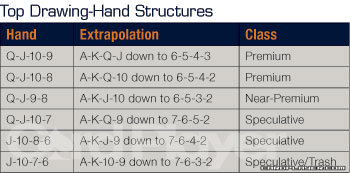






Pot-Limit Omaha: Top Drawing-Hand StructuresBig Straight Drawsby Jeff Hwang | Published: May 21, 2008 |
|
|
Before I discuss shorthanded play in a future column, I should first write a bit about big straight draws and the top drawing-hand structures used to flop them. This is not only because I think it is essential to understanding how to play full-ring pot-limit Omaha (PLO) proficiently -- the big pots in PLO tend to center around straight draws -- but also because I think it will be helpful in understanding how full-ring and shorthanded play differ.
The table below illustrates the big straight draws on the three basic flop types needed to produce as much as a 13-card wrap. Note that in order for as much as a 13-card wrap to be present, the flop must have either two connecting cards (as in 9-8-X), two cards with a single gap (as in 9-7-X), or two cards with a two-gap between them (as in 9-6-X).

Here are a few key ideas:
1. It is better to be on top -- In the last issue, I discussed "Dominating Draws," and this is where it starts. If you want to be on the dominant end in a big pot, you have to be on top of the board. The 13-card nut wraps -- Q-J-10-X on a 9-8-2 flop, J-10-8-X on a 9-7-2 flop, and 10-8-7-X on a 9-6-2 flop -- all require being wrapped on the top end of the board; in contrast, the 13-card sucker wraps with only three nut outs (in the case of the 9-8-2 and 9-7-2 flops) and seven nut outs (in the case of the 9-6-2 flop) are on the bottom end. The same is true of the 16-card wraps, while the 17-card wraps can be dominated by the 13-card nut wraps, as well.
Needless to say, it is never a good thing to be dominated in Omaha poker.
2. Structure: Part I -- There is very little that is random about straight draws. It takes certain kinds of hand structures in order to flop a wrap; a disparate hand like K-10-7-2, for example, can't flop a wrap. In contrast, a perfect four-card rundown like J-10-9-8 can flop 13-card nut wraps in multiple ways (7-6-X, 8-7-X, 9-7-X, 10-7-X). Meanwhile, it is also noteworthy that in order to flop a 16-card wrap or bigger utilizing only two boardcards on the flop, your starting hand must have a gap in it.
3. Structure: Part II -- In order to flop the mighty 16-card nut wrap using only two boardcards, you have to have a hand with the same structure as Q-J-10-7 (a rundown with a two-gap at the bottom) or Q-J-9-7 (a rundown with connectors on top and two single gaps at the bottom); the only additional hand that can flop a 16-card nut wrap with two boardcards is A-K-10-9 on a Q-J-X board. According to Bill Boston in Omaha High-Low, the odds of hitting the two key cards are a long shot at about 25-1 against, though it is also true that there are other ways to win a hand without flopping a wrap; as such, these structure hands are often playable, particularly from late position.
In order to flop a 20-card wrap utilizing only two boardcards, your hand must have the J-10-7-6 structure (a rundown with a two-gap in the middle). However, flopping even the 20-card wrap leaves you easily dominated by a 13-card nut wrap: J-10-7-6 is nearly a 2-1 dog against Q-J-10-X on a 9-8-X flop. As such, while many sophisticated PLO players would play the J-10-7-6 structure hand (and I do myself), I think it tends to be overrated.
Premium Versus Speculative Drawing-Hand Structures
I've ranked the best drawing hands by structure below. The four-card rundown, such as J-10-9-8, has the best chance of hitting the flop strongly; in addition to being able to flop a 13-card wrap in multiple ways, anytime you flop top two pair, you also will have an open-end straight draw to go with it. Despite the gap, J-10-9-7 also is a top hand, while J-10-8-7 is a bit more marginal. Both hands can flop wraps and have pair plus 17-card wrap possibilities, while the J-10-8-7 has a remote 20-card wrap possibility. These structures are the premium and near-premium drawing-hand structures, and these types of hands are almost always playable when at least single-suited.
Q-J-10-7 is another hand that has big draw potential, and is usually worth playing from any position; Q-J-9-7, similarly, has big draw potential. The Q-J-8-7 hand can flop a 20-card draw, but is a bit more marginal. These are the speculative but high-potential drawing-hand structures. As such, you would like to see the flop, but cheaply if possible, especially when playing out of position (meaning that these hands should usually be thrown away from early position in games in which you can expect the pot to be raised before the flop). Note that one of the other drawbacks to these speculative hands is that in contrast to the "premium" hands, flopping top two pair usually results in a one-way hand.

Also note that none of these hands contains a gap at the top of the hand, as having a gap at the top marginalizes virtually all drawing hands (with the exception of A-Q-J-X or A-Q-10-X), for reasons discussed in depth in Pot-Limit Omaha Poker: The Big Play Strategy. 
Jeff Hwang is a semiprofessional player and author of Pot-Limit Omaha: The Big Play Strategy. Jeff is also an investment analyst who writes about casino stocks for the Motley Fool at Fool.com. For a list of live PLO games near you, check out Jeff's website at jeffhwang.com.